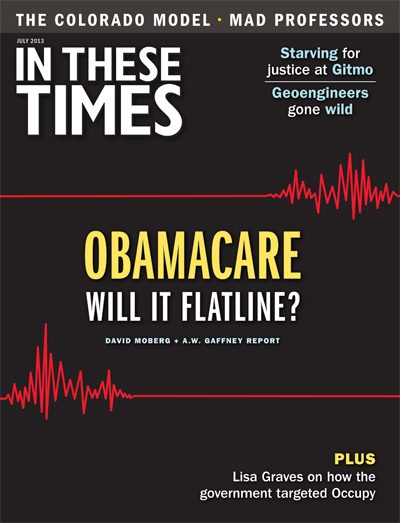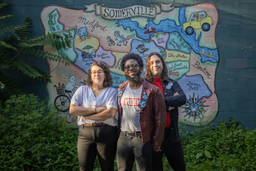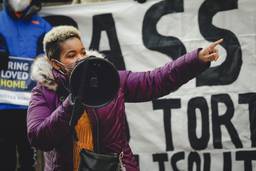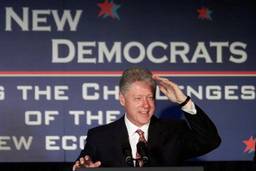Out of the Pen and Unrepentant
Environmentalist Tim DeChristopher on the future of climate activism.
Rebecca Burns
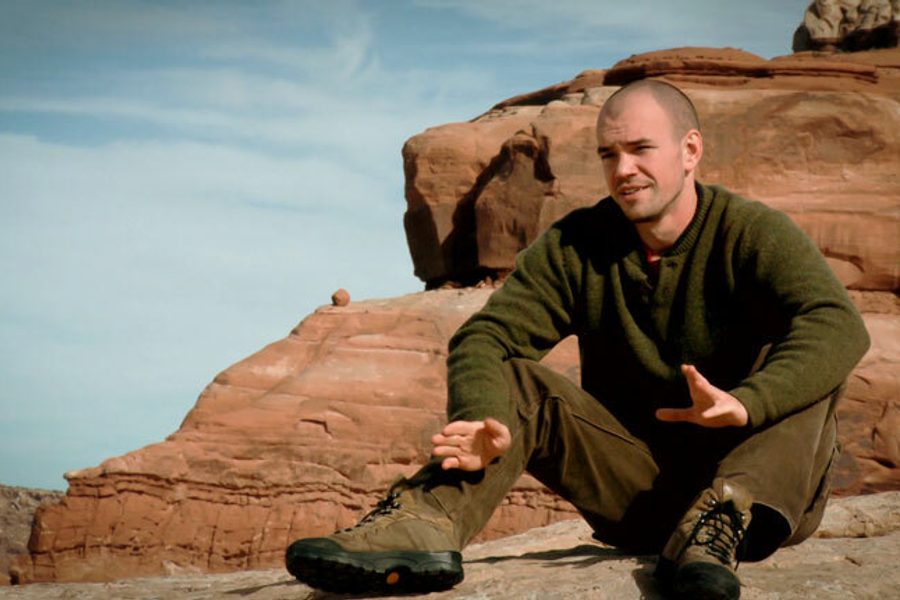
When climate activist Tim DeChristopher was released from federal prison on April 21, he emerged to find a movement transformed. The action that landed DeChristopher in prison — posing as a bidder in order to disrupt an oil and gas lease auction in 2008 — came at a time when the environmental movement typically shied away from such acts of civil disobedience.
Then a college student at the University of Utah, DeChristopher went on to found the group Peaceful Uprising, a climate-justice group that trains volunteers in nonviolent direct action.
The auction that DeChristopher interrupted — which would have seen the drilling rights to thousands of acres of Utah wilderness sold off to corporations — was eventually invalidated by the Obama administration. But that didn’t stop the U.S. attorney’s office from pressing charges against DeChristopher. In March 2011, he was convicted of two felonies and sentenced that July to two years in prison. But far from dampening the spirits of other activists, DeChristopher’s example helped create a groundswell of popular resistance to the fossil fuel industry. Now that he’s a free man, DeChristopher, 31, has rejoined the movement and resumed his work to help embolden others “to take the actions we know need to be taken.” He spoke to In These Times from his home in Salt Lake City.
Before you went to prison, you gave a speech where you said that we’re being pushed closer to climate catastrophe not only by the fossil fuel lobbies, but by “the cowardice of the environmental movement.” Do you feel this way now?
We’re moving in the right direction now. Grassroots climate-justice groups have grown to the point where they’re no longer waiting for the Big Green groups to take action. As a result, we’re also starting to see some of those big groups start to move a little bit — the Sierra Club engaging in civil disobedience [for the first time in its history] during a February demonstration against the Keystone XL pipeline, for example.
What’s next in the battle against Keystone?
The Keystone fight could prove to be a defining moment politically for the climate movement. Typically, we see a big divide between those who are doing grassroots organizing in frontline communities and those who are trying to work for political change in Washington. The Keystone fight has combined those elements, and I think we’ve seen a stronger result because of it.
If we win this battle — which I still think we will — it’s going to drive a wedge between the fossil fuel industry and the Obama administration, and I think that will make other victories inevitable down the road. It’s the same way that the Freedom Rides [to combat segregation] forced the Kennedy administration to take a solid position on civil rights.
Are there other moments in social movement history that you think today’s environmental campaigners could learn from?
One leader in particular who inspires me is Alice Paul from the women’s suffrage movement. She came to the movement at a time when it had spent decades educating the public but not winning much tangible success, and she said, “I think it is time for us to stop begging for our rights and to start demanding them.” The confrontational tactics she advocated produced some pretty shocking images for the time — women getting beaten up and dragged away by cops, women engaging in hunger strikes and being force fed while they were locked up — and really forced the country into a choice. After that, the movement won a constitutional amendment in a relatively short amount of time.
The environmental movement is in a similar position today. We have spent decades doing general education, and if we were to draw some clear lines right now, I think most of the country would come down on our side.
Is it just a matter of bolder actions, or does the climate-justice movement also need bigger numbers and stronger alliances with other Left movements?
We do need those alliances, and there’s already an important shift of consciousness underway. A few years ago, when environmental leaders would talk about building alliances beyond the movement, they were talking about building alliances with corporations, with the military-industrial complex, with those at the top of the power structure. The climate movement today understands that our natural allies are not those who profit from the status quo; it’s those who are being exploited by it and are fighting to change it.
In prison, you spent time in solitary confinement. How did you cope?
I was kept in solitary for 22 days. Most people break down in a serious way after about 50 days. I could hear this happening while I was in isolation — the person next to me screaming, banging his head against the walls, the sounds of someone literally losing his mind. I am grateful I didn’t have to spend any longer in there, but it also gives me a lot of sympathy for others in this situation, whether they be political prisoners like Bradley Manning or just average prisoners who are isolated for no reason. One of the biggest things I took away from my time in prison was that the injustice of my situation, which outraged so many people who were following my case, is really not unusual for our justice system.
During the 21 months you spent in prison, did you feel isolated from the movement?
I had a strong network of support, and got lots of letters and visits. One of the important things that held off any feelings of alienation, though, is that the movement didn’t stop while I was in prison. The month after I got locked up, people protesting Keystone outside of the White House started getting arrested. It was extremely encouraging to see people continuing to fight, because one of my biggest fears was that the government would be successful in their attempts to use me to intimidate others. But others actually found empowerment through my example.
Are you concerned that the example people take from you will be about your courage as an individual, rather than the importance of broader movements?
It’s weird being, in some ways, a symbol more than a person. But I’ve been careful to control the narrative behind my story and not to let it be written by those who just wanted to make me into some kind of icon in order to justify their own inaction. What I wanted people to take from my story was that even if someone is acting as an individual, they really are connected to a movement that is much bigger, and that will hold them and support them and amplify their actions.
What brought you to this belief in the power of movements? How did you first get involved in climate activism?
When I was growing up in West Virginia, my mother was an activist fighting the coal industry in the early days of mountaintop removal. I had that example, and I had an environmental consciousness that came from the way I was brought up, but that didn’t necessarily translate into action. I spent quite a few years as an armchair activist, signing petitions and pretty much sticking to my normal life. What pushed me out of that comfort zone and into action was really just coming to grips with the severity of the climate crisis and going through a period of despair of realizing how late in the game we are. And then coming to understand what needed to change and who I was going to have to be to create that change.
Do you still feel that despair? Some in the environmental movement suggest it’s too late to avert catastrophic climate crisis through a mass movement, and that the best we can do is to mount local initiatives to boost resilience or coordinate mutual aid. Why continue organizing?
It is too late to avert catastrophic climate change. But I don’t think that means it’s the end of the line. We’re about to face the most rapid changes that our society has ever seen, and that makes activism more important than ever, because it matters hugely who is in control as we go through that process. Collapse in a world of engaged citizens who feel like they can direct the course of society looks radically different than collapse in a world where citizens are afraid of their own government and feel like they have to be obedient to corporate control. Our goal at this point is to navigate this path of rapid change in a way that maintains our humanity and brings us through to a place on the other side where we are living more in accordance with our values. That’s what drives me now.

I hope you found this article important. Before you leave, I want to ask you to consider supporting our work with a donation. In These Times needs readers like you to help sustain our mission. We don’t depend on—or want—corporate advertising or deep-pocketed billionaires to fund our journalism. We’re supported by you, the reader, so we can focus on covering the issues that matter most to the progressive movement without fear or compromise.
Our work isn’t hidden behind a paywall because of people like you who support our journalism. We want to keep it that way. If you value the work we do and the movements we cover, please consider donating to In These Times.
Rebecca Burns is an In These Times contributing editor and award-winning investigative reporter. Her work has appeared in Bloomberg, the Chicago Reader, ProPublica, The Intercept, and USA Today. Follow her on Twitter @rejburns.
